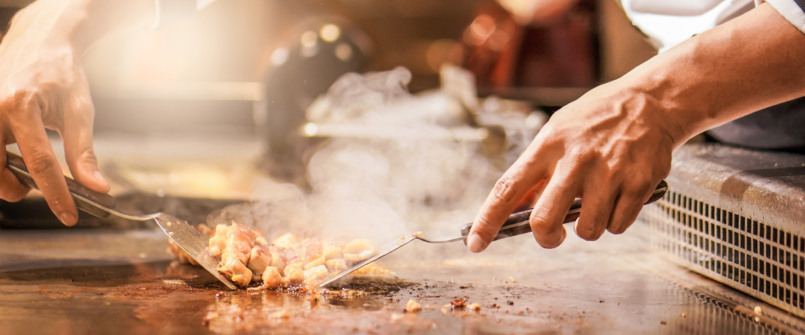
Educational, Food Service/Processing
Commercial Griddle Cleaning: Why and How to Do it
Griddles are great for cooking a wide variety of foods in a commercial kitchen, but they need care and attention to keep them performing their best. Ignoring griddle maintenance can not only be disastrous for your equipment, it can seriously affect the taste and safety of the food you serve. Fortunately, griddle cleaning is a pretty quick process. Set aside time to care for this kitchen workhorse and it will repay you with a long life to keep your kitchen operation sizzling.
Why Fiddle with the Griddle?
The most important reason to keep your griddle clean is to lessen the chance that contaminants will get into cooked food, possibly causing disease or illness. Consistent cleaning also improves the taste of food, since it reduces the likelihood that flavors will transfer from one menu item to another. Regularly eliminating the buildup of grease and food particles from griddles and grills helps surface heat conduct more evenly and efficiently and extends the life of equipment, giving you the best return on your investment.
Short Order Guide to Griddle Cleaning
Routine griddle cleaning will help kitchen staff save time in the long run, since accumulated grease and grime can form a sticky layer that will eventually carbonize into an extremely difficult-to-remove substance. Have the necessary equipment at hand to make the process go quickly, including PPE, griddle scraper or stone, clean cloths, cooking oil and grill/oven cleaner. You’ll want to be sure any cleaning products you use are safe for your griddle surface, whether it be non-chromium, stainless, chrome-plated or double-plated. Follow these steps to do a quick clean during cooking shifts:
- Begin with a grill that is warm to the touch, but not hot. Note: Your griddle may come equipped with a “clean” function that indicates when equipment is at a safe temperature.
| PRO TIP: Never use ice to cool or clean a griddle! The cold cubes combine with the hot surface to cause a rapid change in temperature that can result in stress cracks. These cracks then expand when the griddle heats up, allowing grease to drip into the inner workings and eventually leading to expensive repairs. |
- Use a heat-resistant rubber scraper or spatula to remove any food buildup. Scrape into grease trough and discard.
| PRO TIP: Test any abrasive cleaning tools on an inconspicuous area before using, or refer to manufacturer’s recommendations. |
- Following the manufacturer’s directions, apply cleaning solution on the griddle surface to break up any stubborn food and grease particles. Nyco’s Attention is a heavy duty cleaner that dispenses as foam but quickly turns to gel, allowing it to remain on surfaces longer. It easily loosens and lifts baked on, carbonized soils.
- Scrub the griddle surface with a griddle brush, pad or stone, making small, concentric circles until cooked on food and carbon is loosened. Be mindful of the type of griddle surface you have and be sure to follow manufacturer instructions.
- Using clean cloths, clean sides and front of griddle as well as around the burner and burner air shutter.
- Use a clean, wet towel or water and rubber squeegee to rinse any cleaner residue from griddle.
| PRO TIP: To prevent damage to equipment, avoid spraying water at high pressure around griddle controls. |
- Rub surface with clean towel soaked in cooking oil to polish and season steel as well as prevent rust.
| ‘TIS THE SEASON If food is sticking to the griddle or you notice rust forming, you may need to re-season your griddle. Simply remove the griddle grate and pre heat to medium. Wash grate thoroughly using a grill brush and degreaser formula. Let dry. Lightly coat grate surface with vegetable shortening, then place in grill; close lid and allow to cook for 10-15 minutes. Repeat these steps until desired seasoning has been achieved. |
Maintenance Checklist
In addition to the quick clean mentioned above, griddles should undergo regular maintenance throughout the year in order to remain at peak performance. Below is a handy guide as to how each task should be performed.
Daily – Most manufacturers recommend cleaning the griddle at least once day, and even more frequently with heavy use. Be sure to empty, wash and sanitize the waste drawer at the end of every day or sooner if needed. Nyco’s At-Eze is available in a ready-to-use formula for daily griddle cleaning.
| PRO TIP: Use only recommended cleaning solutions. Avoid bleach or harsh chemicals, especially on chrome surfaces. |
Weekly – Once a week, unplug the griddle and allow to cool completely. Use a fresh cloth and non-abrasive griddle cleaner to clean the surface, then thoroughly rinse with water. Read these instructions for a more detailed procedure list.
Monthly – Check and recalibrate the thermostat every few weeks with a surface thermostat or laser surface thermometer.
Quarterly – Look for stress cracks in the metal. Any damage should be addressed immediately, since cracks can allow grease to seep into the mechanics and damage the equipment.
Twice a year – Do a visual inspection of the top and underside of the griddle. Also check the pressure on gas griddles or have a professional service tech check the amp reading on electric griddles.
No need to flip out over griddle cleaning! By making it a regular part of the kitchen routine, staff can avoid wasting valuable time scraping food debris and grease from the surface. Plus, you’ll have added peace of mind knowing equipment is less likely to experience a break down or need replacement. Most important, you’ll be ensuring that your food service establishment is a safe, enjoyable place to dine by reducing the chances of food contamination and the dreaded flavor transfer that can occur from a dirty griddle.
# # #
You may also be interested in…
